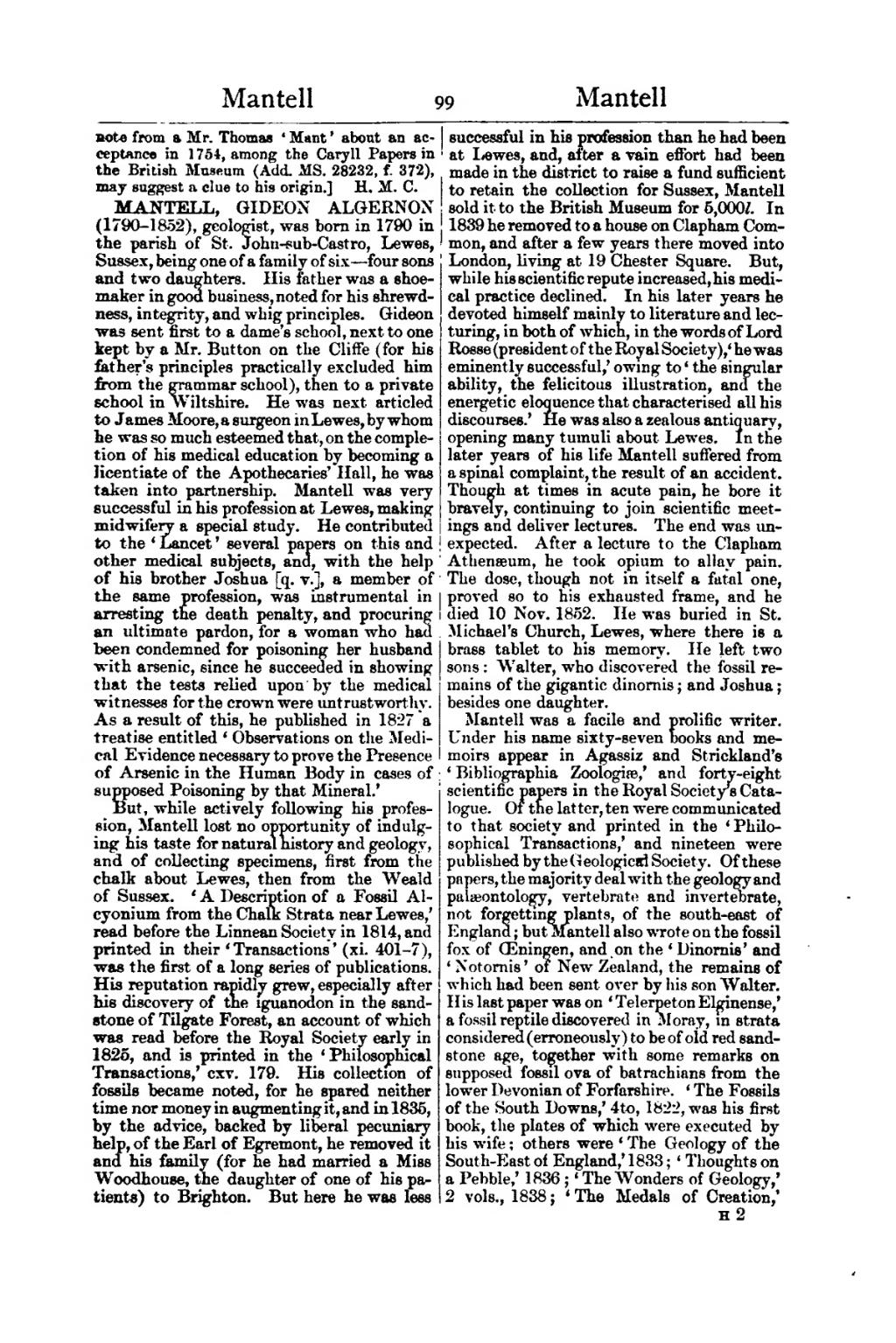MANTELL, GIDEON ALGERNON (1790–1852), geologist, was born in 1790 in the parish of St. John-sub-Castro, Lewes, Sussex, being one of a family of six—four sons and two daughters. His father was a shoemaker in good business, noted for his shrewdness, integrity, and whig principles. Gideon was sent first to a dame's school, next to one kept by a Mr. Button on the Cliffe (for his father's principles practically excluded him from the grammar school), then to a private school in Wiltshire. He was next articled to James Moore, a surgeon in Lewes, by whom he was so much esteemed that, on the completion of his medical education by becoming a licentiate of the Apothecaries' Hall, he was taken into partnership. Mantell was very successful in his profession at Lewes, making midwifery a special study. He contributed to the ‘Lancet’ several papers on this and other medical subjects, and, with the help of his brother Joshua [q .v.], a member of the same profession, was instrumental in arresting the death penalty, and procuring an ultimate pardon, for a woman who had been condemned for poisoning her husband with arsenic, since he succeeded in showing that the tests relied upon by the medical witnesses for the crown were untrustworthy. As a result of this, he published in 1827 a treatise entitled ‘Observations on the Medical Evidence necessary to prove the Presence of Arsenic in the Human Body in cases of supposed Poisoning by that Mineral.’
But, while actively following his profession, Mantell lost no opportunity of indulging his taste for natural history and geology, and of collecting specimens, first from the chalk about Lewes, then from the Weald of Sussex. ‘A Description of a Fossil Alcyonium from the Chalk Strata near Lewes,’ read before the Linnean Society in 1814, and printed in their ‘Transactions’ (xi. 401–7), was the first of a long series of publications. His reputation rapidly grew, especially after his discovery of the iguanodon in the sandstone of Tilgate Forest, an account of which was read before the Royal Society early in 1825, and is printed in the ‘Philosophical Transactions,’ cxv. 179. His collection of fossils became noted, for he spared neither time nor money in augmenting it, and in 1835, by the advice, backed by liberal pecuniary help, of the Earl of Egremont, he removed it and his family (for he had married a Miss Woodhouse, the daughter of one of his patients) to Brighton. But here he was less successful in his profession than he had been at Lewes, and, after a vain effort had been made in the district to raise a fund sufficient to retain the collection for Sussex, Mantell sold it to the British Museum for 5,000l. In 1839 he removed to a house on Clapham Common, and after a few years there moved into London, living at 19 Chester Square. But, while his scientific repute increased, his medical practice declined. In his later years he devoted himself mainly to literature and lecturing, in both of which, in the words of Lord Rosse (president of the Royal Society), ‘he was eminently successful,’ owing to ‘the singular ability, the felicitous illustration, and the energetic eloquence that characterised all his discourses.’ He was also a zealous antiquary, opening many tumuli about Lewes. In the later years of his life Mantell suffered from a spinal complaint, the result of an accident. Though at times in acute pain, he bore it bravely, continuing to join scientific meetings and deliver lectures. The end was unexpected. After a lecture to the Clapham Athenæum, he took opium to allay pain. The dose, though not in itself a fatal one, proved so to his exhausted frame, and he died 10 Nov. 1852. He was buried in St. Michael's Church, Lewes, where there is a brass tablet to his memory. He left two sons: Walter, who discovered the fossil remains of the gigantic dinornis; and Joshua; besides one daughter.
Mantell was a facile and prolific writer. Under his name sixty-seven books and memoirs appear in Agassiz and Strickland's ‘Bibliographia Zoologiæ,’ and forty-eight scientific papers in the Royal Society's Catalogue. Of the latter, ten were communicated to that society and printed in the ‘Philosophical Transactions,’ and nineteen were published by the Geological Society. Of these papers, the majority deal with the geology and palæontology, vertebrate and invertebrate, not forgetting plants, of the south-east of England; but Mantell also wrote on the fossil fox of Œningen, and on the ‘Dinornis’ and ‘Notornis’ of New Zealand, the remains of which had been sent over by his son Walter. His last paper was on ‘Telerpeton Elginense,’ a fossil reptile discovered in Moray, in strata considered (erroneously) to be of old red sandstone age, together with some remarks on supposed fossil ova of batrachians from the lower Devonian of Forfarshire. ‘The Fossils of the South Downs,’ 4to, 1822, was his first book, the plates of which were executed by his wife; others were ‘The Geology of the South-East of England,’ 1833; ‘Thoughts on a Pebble,’ 1836; ‘The Wonders of Geology,’ 2 vols., 1838; ‘The Medals of Creation,’
